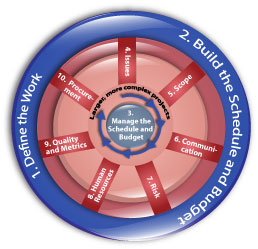 |
 |
![]()
9.0 Manage Quality and Metrics
Quality is ultimately defined by the
customer and represents how close the project and deliverables come to
meeting the customer’s requirements and expectations.
The old adage about quality being in the
eyes of the beholder is true - quality is ultimately measured by your
customer. It is
not up to the project team to determine the level of quality required
for the project. The project team needs to understand the
customer's requirements and
expectations - and then meet those expectations.
High-level process flow
This is a critical concept about quality.
Sometimes there is a tendency to think that 'quality' means the best
material, the best equipment and absolutely zero defects. However, in most cases, the
sponsor does not
expect, and cannot afford, a perfect solution. If there are a few bumps
in the project or a few defects in the deliverable, the customer can still
say that the solution was delivered with a high level of quality. On the
other hand, a flawlessly designed, defect-free solution that does not
meet the customer's needs is not considered high quality. The purpose of
quality management is to first understand the expectations of the
customer
in terms of quality and then put a proactive plan in place to meet those
expectations.
Since quality is defined by the
customer, it
may seem that it is completely subjective. However, there is a lot about
quality that can be made objective. This requires first breaking down
the generic term of 'quality' into the specific aspects of quality that
are important to the customer. Then, you look at each of the individual
aspects and determine one or more metrics that can be collected to
measure the characteristic. For instance, one of the features of a
quality solution may be that it has a minimum amount of errors. This
characteristic can be measured by counting errors and defects after the
solution goes live.
In addition to understanding the customer’s
definition of quality, it is important to recognize other stakeholder’s
interests as well. Depending on the roles of the stakeholders, they may
have other quality requirements that need to be satisfied. For instance:
The company – The solution meets
strategic goals
Buyers - The solution meets
specifications
End users – The solution helps them do
their job better, faster, easier
IT support organization – The solution
is stable, has few bugs, is understandable and can be modified
easily
Managing
metrics and managing quality are related. It is very difficult to
improve the quality of your deliverables or your efficiency of your
processes if you are not gathering metrics. Metrics are used to give
some indication of the beginning state of quality (quality of
deliverables and quality of project processes) and whether quality is
increasing or decreasing. In addition to determining the level of
quality on a project, metrics can also be used to provide objective
criteria to determine if your project was successful. This is the
purpose of the project scorecard.
Click here to better understand the nature of quality
management -
9.0.1 Understanding the Nature of Quality Management.
[Previous -
Manage Human Resources / Example]
[Next - 9.0.1 Understanding the Nature of Quality Mgmt] (9.0.P1)
(9.0.P1)

![]() 9.1.3.1
Manage Metrics / Process
9.1.3.1
Manage Metrics / Process![]() 9.2 Manage Quality / Techniques
9.2 Manage Quality / Techniques![]() 9.2.1 Manage
Metrics /
Techniques
9.2.1 Manage
Metrics /
Techniques![]() 9.3 Manage Quality / Quick Reference
9.3 Manage Quality / Quick Reference